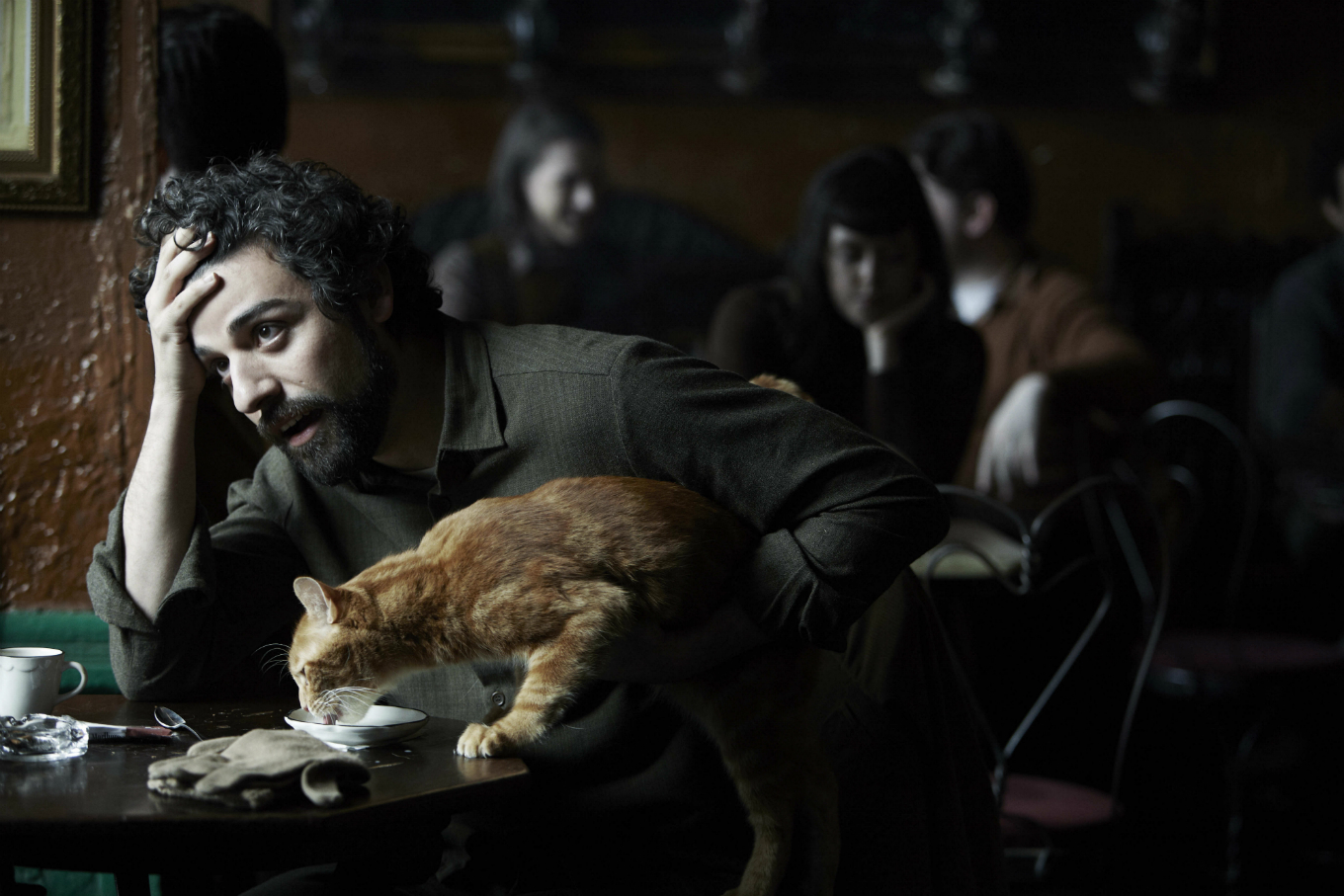In Inside Llewyn Davis, the titular protagonist (Oscar Isaac) is yet another one of Coens’ unlucky characters, bewildered by the cruel twists of fate. But what separates Davis—loosely based on folk musician Dave Van Ronk—from the brothers’ other protagonists is acknowledgement. Davis struggles to get by in early-1960s Greenwich Village, drifting from one friend’s couch to the next, holding out for his lucky break—and yet, he’s wise to and jaded by the precariousness of his profession.
Though Davis’ peevish personality does not exactly attract much sympathy, the film complicates the nature of his circumstances. The young musician doesn’t deal well with the blows that are given to him, oscillating between eagerness when he he sees an opportunity and exasperation when it is inevitably squandered. But it’s easy to see that Davis also lives in a world that simply doesn’t care much for him, and it’s hard not to sympathize, if not directly with Davis himself, then indirectly with the situation of accumulating soul-crushing experiences. Few peripheral characters care about his well-being (or existence), and even his well-meaning friends are prone to condescending moments, as when the Gorfeins, his Upper West Side academic friends, proudly introduce him as their “folk musician” friend as if he were an exotic pet. There’s Jean (Carey Mulligan), Davis’ bitter ex-girlfriend upset with the fact that he impregnated her and who is always eager to tell him off for being an asshole (we never actually see signs of this assholery, but one can only surmise that Davis would make a pretty wretched lover). Mel (Jerry Grayson), his well-meaning but useless manager, hasn’t filed any royalties from Davis’ albums.
One of the more significant junctures in the film’s narrative finds Davis taking a depressing and seemingly endless road trip to Chicago in order to audition for Bud Grossman (F. Murray Abraham), manager and owner of the Gate of Horn. Davis just barely makes it, after having to carpool with a near-mute beatnik poet Johnny Five (Garrett Hedlund) and an elitist, loquacious jazz musician Roland Turner (John Goodman), whose vices and embittered personality encapsulate the sad future that their shared profession may hold in store for Davis. In Chicago, an uninviting, poker-faced Grossman allows Davis to play a song, only to tell him in a deadpan, matter-of-fact tone: “I don’t see much money here.”
Inside has a somewhat unusual narrative structure: not much happens, since the viewer is only privy to about a week’s time in Davis’ life, though many of the events function like new rock bottoms for Davis. Even positive happenings backfire, like when he finds the Gorfeins’ ginger cat on the street days after losing it, only to find out in an embarrassing and emotional scene that it’s not the same cat. Davis enthusiastically agrees to fill in for a guitarist last minute for the studio recording of fellow musician Jim’s (Justin Timberlake) song, a gig that gives Davis a much-needed $200. Not only is Jim’s space-travel-oriented ditty, “Please Mr. Kennedy,” downright ridiculous and gimmicky—it features musician Al Cody’s (Adam Driver) silly, intermittent vocal accompaniment that can be best described as musical Tourette’s syndrome—the manager aggressively negotiates Davis’ agreement to accept no royalties from its sales, to which Davis is more than happy to oblige since he will then receive money for labor upfront. Davis also assumes the song won’t do well, but in a later scene the Gorfeins’ friends not only praise the same tune ebulliently, one mentions how it’s destined for strong radio play and plentiful royalties.
And then there’s the cat. Ulysses is the on-the-nose name of the Gorfeins’ wandering ginger feline who finds itself inadvertently in Davis’ care. Not that he is actually capable of taking care of the animal, quickly established in a scene when the cat disappears out of Jean’s window. Davis can barely take care of himself, let alone another creature, and he is tested several times whether or not he has the wherewithal to play cat-sitter. When Davis finds the cat (the wrong one) and is once again tested and forced to take care of it, his own precarious situation on the highways between Chicago and New York forces him to give up on the kitty once more, but it’s not the last time he sees the animal. Driving back to NYC, tired and bleary-eyed, Davis ends up hitting the cat with the car. When he pulls over to see if it survived, he finds the poor creature limping into the forest, presumably where it can die. In a sense, the aimless paths of the two felines in this story are parallel to Davis’ own shambling existence. Nimble and quick on his feet, Davis does whatever he can to get by. Each new chapter in his life—when he fails to sign with Grossman, when he decides to re-join a ship as a seaman, when he plays yet another set at the Gaslight Cafe—is like a new life, yet he seems to quickly be coming up on his ninth (or umpteenth).
The only time Davis appears to be in his element is when he’s performing. It’s in these rare moments where the viewer really gets to see Davis’ soul and humanity shining through his wall of cynicism, and though it’s without question the character has talent, the sometimes tactless observations from others proves that Davis simply doesn’t have the pizazz, warmth, pale Caucasian skin, or novel gimmick necessary to succeed as a popular folk musician. Inside makes plenty of references and nods to the era in a way that serves as more than mere window dressing and certain characters are very obviously stand-ins for real figures in the American music industry, like Grossman’s resemblance to Al Grossman, who owned the real Gate of Horn and was manager of hot-property acts like Bob Dylan and Peter, Paul and Mary. The film’s timing is also notable: 1961 is the year before the folk revival became an explosion, with the discoveries of Dylan, Joan Baez, and Peter, Paul and Mary, when the genre held promise for acts similar to the already-famous Kingston Trio. Therefore, Davis’ dreams of success are not unwarranted, but the man doesn’t know how to plan for his future (when asked about exactly that, his answer is the hilarious and telling quip, “You mean like flying cars?”).
The Coens have always had a knack for fictionalizing chapters from American history with mysticism and verve, but Inside is the closest they get to a real historicist picture. Yet there remains some bewitchment in its visual signature. The limping feline in the forest, with its serene grace and moonlit side profile, might as well be a magical beast, ready like a phoenix to respawn. The daytime inertia in the Gate of Horn, with its dusty air and acoustic echos, might as well be the gates of hell. The Coens adorn their moving images with precise historical detail—like the wintery, desolate streets of NYC taken right from the cover of The Freewheelin’ Bob Dylan, and the bleak, muted colors of hipsters’ sweaters—in order to amplify the forlornness of Davis’ predicament, and make us witness to the overlooked derelict loneliness of an era that’s been traditionally beloved and imbued with nostalgia.

